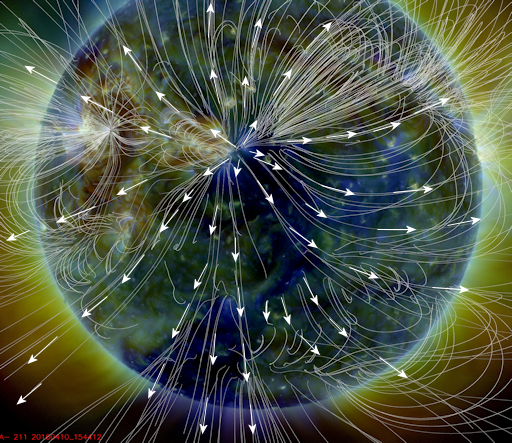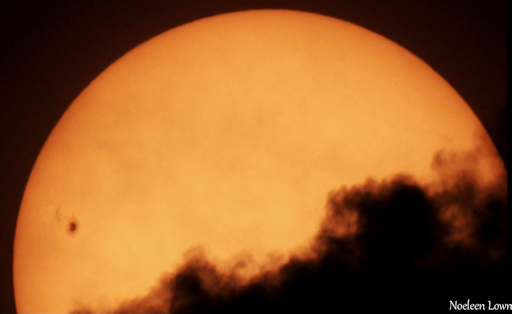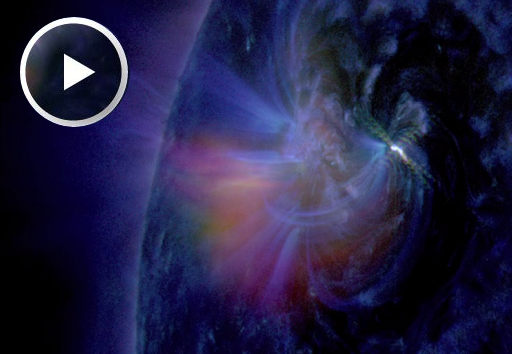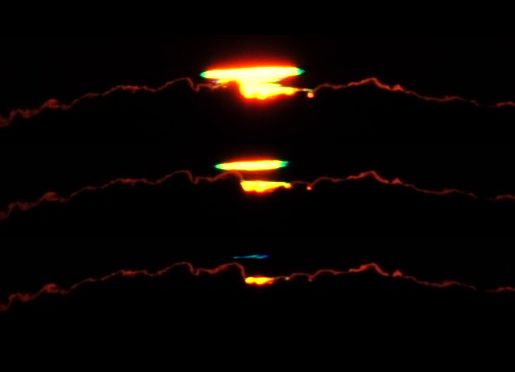Marianne's Heaven On Earth Aurora Chaser Tours Chasethelighttours.co.uk invites you to join them in their quest to find and photograph the Aurora Borealis. Experience the winter wonderland in the Tromsø Area. | | | AURORAS THIS WEEK? NOAA forecasters say there is a 50% chance of G1-class geomagnetic storms on April 13th when a solar wind stream is expected to hit Earth's magnetic field. High-latitude sky watchers should be alert for auroras. The incoming solar wind stream is pouring out of a hole in the sun's atmosphere--a "coronal hole"--shown in this image from NASA's Solar Dynamics Observatory: 
Coronal holes are places in the sun's upper atmosphere where the magnetic field peels back and allows solar wind to escape. In the image, above, the sun's magnetic field is traced by pale arcing lines. Arrows indicate the flow of solar wind. All solar wind streams carry some of the sun's magnetic field into space. The stream now heading for Earth appears to be filled with "negative polarity" magnetic fields. Such fields can easily link to Earth's magnetic field, opening a crack in our planet's defenses against solar wind. As a result, this solar wind stream could be effective at sparking auroras. Aurora alerts: text or voice Realtime Aurora Photo Gallery BIG SUNSPOT: The sun's headlong plunge into solar minimum has been interrupted by the surprise emergence of a big sunspot. AR2529 doubled in size over the weekend, and the behemoth spot is now being photographed by amateur astronomers around the world. "I just managed to capture this magnificent sunspot late yesterday afternoon in between the dark thundering clouds with the video feature on my Canon 700D camera," reports Noeleen Lowndes of Leyburn QLD Australia: 
"It's been a long time since we've had such a beauty on the Sun's surface," says Lowndes, "and I can't wait to see how it's going to progress in the next few days." A coronal mass ejection (CME) from this sunspot may be approaching Earth. The plasma cloud left the region on April 10th during an hours-long period of unrest in the sunspot's core, documented in this movie from NASA Solar Dynamics Observatory: 
During the sequence, a magnetic flux tube disconnected and reconnected, expelling plasma out into space. The CME, along with another that occurred a few hours later, could deliver a glancing blow to Earth's magnetic field on April 13th. Solar flare alerts: text or voice Realtime Space Weather Photo Gallery EXOTIC GREEN FLASH: Seaside photographers have a special fondness for the sunset. On rare occasions they can catch the elusive green flash--a split-second pulse of verdant light that signals the disappearance of the sun beneath the ocean waves. On April 7th, astronomy professor Jimmy Westlake photographed a green flash as he stood atop Hawaii's Mauna Kea volcano. The flash he saw, however, did not come from the ocean waves. It happened in the clouds: 
"The SKY Club from Colorado Mountain College got an emerald surprise," he says. "Several students visually witnessed the green flash while I was photographing it." "This appears to be a cloud-top flash," says atmospheric optics expert Les Cowley. "They are not fully understood but might be produced by an inversion layer overlaying the clouds." Basically, a temperature inversion bends the sun's rays to form a mirage that vertically magnifies the tiny color separation which is always present at the edge of the setting sun. In Westlake's flash, we see not only green, but also yellow, red, and even a wisp of blue. "The intensity of the blue-green flash caught everyone by surprise!" says Westlake.
Realtime Aurora Photo Gallery
Solar Eclipse Photo Gallery
Realtime Comet Photo Gallery
[More about Comet 252P: brightness measurements, 3D orbit, orbital elements] Every night, a network of NASA all-sky cameras scans the skies above the United States for meteoritic fireballs. Automated software maintained by NASA's Meteoroid Environment Office calculates their orbits, velocity, penetration depth in Earth's atmosphere and many other characteristics. Daily results are presented here on Spaceweather.com. On Apr. 11, 2016, the network reported 2 fireballs.
(2 sporadics)  In this diagram of the inner solar system, all of the fireball orbits intersect at a single point--Earth. The orbits are color-coded by velocity, from slow (red) to fast (blue). [Larger image] [movies] Potentially Hazardous Asteroids ( PHAs) are space rocks larger than approximately 100m that can come closer to Earth than 0.05 AU. None of the known PHAs is on a collision course with our planet, although astronomers are finding new ones all the time. On April 11, 2016 there were potentially hazardous asteroids. Notes: LD means "Lunar Distance." 1 LD = 384,401 km, the distance between Earth and the Moon. 1 LD also equals 0.00256 AU. MAG is the visual magnitude of the asteroid on the date of closest approach. | | Cosmic Rays in the Atmosphere | | Situation Report -- Oct. 30, 2015 | Stratospheric Radiation (+37o N) | | Cosmic ray levels are elevated (+6.1% above the Space Age median). The trend is flat. Cosmic ray levels have increased +0% in the past month. | | Sept. 06: 4.14 uSv/hr (414 uRad/hr) | | Sept. 12: 4.09 uSv/hr (409 uRad/hr) | | Sept. 23: 4.12 uSv/hr (412 uRad/hr) | | Sept. 25: 4.16 uSv/hr (416 uRad/hr) | | Sept. 27: 4.13 uSv/hr (413 uRad/hr) | | Oct. 11: 4.02 uSv/hr (402 uRad/hr) | | Oct. 22: 4.11 uSv/hr (411 uRad/hr) | These measurements are based on regular space weather balloon flights: learn more. Approximately once a week, Spaceweather.com and the students of Earth to Sky Calculus fly "space weather balloons" to the stratosphere over California. These balloons are equipped with radiation sensors that detect cosmic rays, a surprisingly "down to Earth" form of space weather. Cosmic rays can seed clouds, trigger lightning, and penetrate commercial airplanes. Our measurements show that someone flying back and forth across the continental USA, just once, can absorb as much ionizing radiation as 2 to 5 dental X-rays. For example, here is the data from a flight on Oct. 22, 2015: 
Radiation levels peak at the entrance to the stratosphere in a broad region called the "Pfotzer Maximum." This peak is named after physicist George Pfotzer who discovered it using balloons and Geiger tubes in the 1930s. Radiation levels there are more than 80x sea level. Note that the bottom of the Pfotzer Maximim is near 55,000 ft. This means that some high-flying aircraft are not far from the zone of maximum radiation. Indeed, according to the Oct 22th measurements, a plane flying at 45,000 feet is exposed to 2.79 uSv/hr. At that rate, a passenger would absorb about one dental X-ray's worth of radiation in about 5 hours. The radiation sensors onboard our helium balloons detect X-rays and gamma-rays in the energy range 10 keV to 20 MeV. These energies span the range of medical X-ray machines and airport security scanners. | | The official U.S. government space weather bureau | | | The first place to look for information about sundogs, pillars, rainbows and related phenomena. | | | Researchers call it a "Hubble for the sun." SDO is the most advanced solar observatory ever. | | | 3D views of the sun from NASA's Solar and Terrestrial Relations Observatory | | | Realtime and archival images of the Sun from SOHO. | | | from the NOAA Space Environment Center | | | the underlying science of space weather | | 
